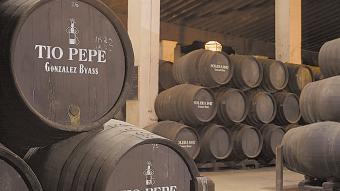Roqueta Origen: eight centuries amid the vines
The Roqueta family’s history has been entwined with wine and the vine since the 12th century. Such a long history grants them licence to look to the past as their birthright, revive forgotten grape varieties such as the radiant white picapoll and reprise age-old methods of production such as ‘vinos de tina’, wines made from grapes pressed in a ‘tina’ or ancient stone tank. Roqueta – a name rooted in the vineyards.
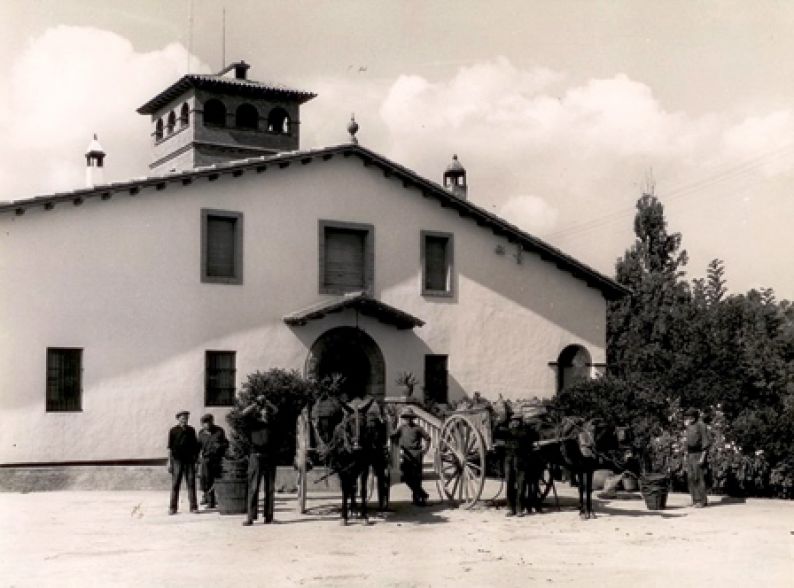
The origins of the Roqueta family date back to the year 1200 and are rooted in the heart of the province of Barcelona, deep in the mountains of the comarca (county) of Bages. This craggy landscape is today populated by pine and oak trees but was once one of the most important wine producing areas in Spain. While phylloxera was laying waste to the French vineyards, grapes were being planted from the lowest to the highest hill peaks of Bages, where the steepness of the terrain is managed with the help of bancal and terrace systems. When the vineyards were wiped out by Phylloxera in neighbouring France and grapes became a scarce commodity, the growers in this part of Catalonia seized the opportunity to make a lot of money from the trading of wine. They never thought for a moment that the accursed phylloxera louse would reach their own vineyards… How could it possibly penetrate such wild, rugged countryside?
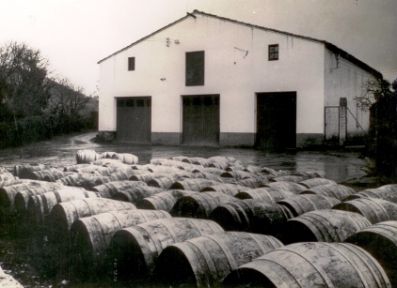 Barrels at the entrance of Masia Roqueta Many, many years before phylloxera lay waste to France and the comarca became rich from the sale of wine, the ancestors of today’s wine producer, Valentí Roqueta, owned vineyards and produced wine. They did this on a beautiful old estate, the Masía Santa Maria de Horta de Avinyó, which, today, has been completely restored. Beneath the house lies a remarkable winery, an absolute gem, complete with lagares (stone troughs in which grapes are trodden) and stone tanks, which has survived the passing of time. In the local county archives, there is mention of a Jaume Roqueta, who is listed as the owner of the Santa María de Horta de Avinyó estate, and one can trace how the estate passed down from father to son over the years and centuries. Some of these were particularly hard times for Bages, notably the 14th century, due to a major rural exodus which saw the comarca abandoned for various reasons including wars and the plague. The Roquetas, however, stayed put, rooted to the soil and the vine and, interestingly, produced many sons who kept the family name going.
Barrels at the entrance of Masia Roqueta Many, many years before phylloxera lay waste to France and the comarca became rich from the sale of wine, the ancestors of today’s wine producer, Valentí Roqueta, owned vineyards and produced wine. They did this on a beautiful old estate, the Masía Santa Maria de Horta de Avinyó, which, today, has been completely restored. Beneath the house lies a remarkable winery, an absolute gem, complete with lagares (stone troughs in which grapes are trodden) and stone tanks, which has survived the passing of time. In the local county archives, there is mention of a Jaume Roqueta, who is listed as the owner of the Santa María de Horta de Avinyó estate, and one can trace how the estate passed down from father to son over the years and centuries. Some of these were particularly hard times for Bages, notably the 14th century, due to a major rural exodus which saw the comarca abandoned for various reasons including wars and the plague. The Roquetas, however, stayed put, rooted to the soil and the vine and, interestingly, produced many sons who kept the family name going.
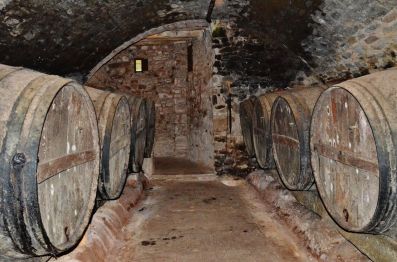
THE GREAT MAN OF BAGES
After Ramón’s death during the Spanish Civil War, his son, Valentí Roqueta Prat, took over at the helm, surmounting the enormous difficulties created by the aftermath of the military conflict. He successfully modernized methods and facilities, including the inauguration of a modern bottling plant which enabled him to diversify his offer hitherto limited to the sale of wine in bulk and casks. 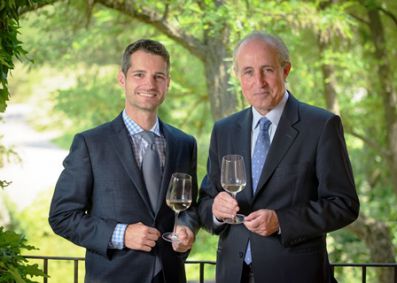 Valentí Roqueta (right) and Ramón Roqueta (left). @Jordi Elias His grandson, the present day, Valentí Roqueta Guillamet, a trained oenologist with a good nose for business, diversified the business and built new wineries. He chose the beautiful, historic location surrounding the ancient Masía Horta de Avinyó, where everything all started, to build a winery named Abadal, in 1983. He became closely involved in the revival of the culture, prestige, vines and history of Bages and in the Pla de Bages Denominación de Origen, created in 2006, of which he is president. At a time when indigenous varieties were looked down upon and many had been grubbed up in favour of the noble French grape varieties that had invaded the Catalan vineyards, Roqueta, with his great love and knowledge of viticulture, persevered in the recovery of a white grape variety called picapoll, the flagship wine of the Abadal bodega.
Valentí Roqueta (right) and Ramón Roqueta (left). @Jordi Elias His grandson, the present day, Valentí Roqueta Guillamet, a trained oenologist with a good nose for business, diversified the business and built new wineries. He chose the beautiful, historic location surrounding the ancient Masía Horta de Avinyó, where everything all started, to build a winery named Abadal, in 1983. He became closely involved in the revival of the culture, prestige, vines and history of Bages and in the Pla de Bages Denominación de Origen, created in 2006, of which he is president. At a time when indigenous varieties were looked down upon and many had been grubbed up in favour of the noble French grape varieties that had invaded the Catalan vineyards, Roqueta, with his great love and knowledge of viticulture, persevered in the recovery of a white grape variety called picapoll, the flagship wine of the Abadal bodega.
Yet his ambition and curiosity were apparently still not satisfied. Another of his major projects was Paisajes 1883 (Landscapes 1883). The date commemorates one of the comarca’s glory years, a time when its wine was considered a veritable treasure. The aim of this fascinating project, which has become reality today, was to restore the old stone tanks or tinas, located in the vineyards, where the wine was once produced and sold. These rudimentary structures made from dry stone were erected in the middle of the vineyards, always beside a stream, amidst the mountains. The grapes were pressed by growers standing over the tanks on wooden boards. The grape juice ran down into the tank below due to the pressure exerted by the feet of the growers, who were only prevented from falling by the use of a simple rope hanging from the primitive stone roofing. There are more than 100 tinas throughout the comarca, but, apart from those restored by the Roqueta family, almost all of them have fallen into disuse. The restored stone tanks and huts are structures of great historical and cultural interest.
THE MOST NATURAL OF NATURAL WINE
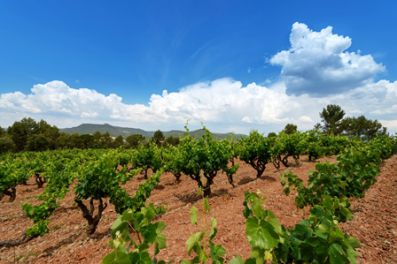 Vineyards at Abadal Winery. @Jordi Elias Roqueta is not only restoring these lovely, rudimentary constructions, he also maintains them in a perfect condition for the production of wine according to 19th-century tradition, without the addition of sulphur and using grapes from the extremely old vines still found growing in the surrounding area. This type of wine is today referred to as ‘natural wine’. So it seems nothing is new under the sun, and even less so for the Roquetas, with so many centuries of viticulture behind them.
Vineyards at Abadal Winery. @Jordi Elias Roqueta is not only restoring these lovely, rudimentary constructions, he also maintains them in a perfect condition for the production of wine according to 19th-century tradition, without the addition of sulphur and using grapes from the extremely old vines still found growing in the surrounding area. This type of wine is today referred to as ‘natural wine’. So it seems nothing is new under the sun, and even less so for the Roquetas, with so many centuries of viticulture behind them.
Before embarking on the Paisajes 1883 project, Roqueta had already set up his first winery outside Catalonia - Bodega Crin Rioja in Fuente del Álamo (Albacete province). He had also created a new winery in Catalonia, in Batea (Tarragona province), known as La Fou Celler. This business is managed personally by his son Ramón, the new, 21st century Ramón Roqueta. This winery produces high-end wines of great depth, in accordance with the family philosophy, using indigenous red and white Garnacha grapes. It is located in an old 17th-century manor house, Can Figueras, in the centre of the old village, which Roqueta restored and converted into a modern bodega, preserving all its beauty.
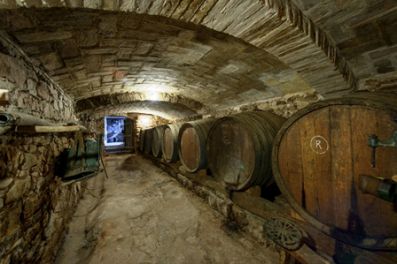 Barrels inside the new winery. @Jordi Elias Valentí Roqueta has also completed another major project. When he was president of the Caixa Rural de Manresa bank, he sponsored the complete restoration of an outstandingly beautiful set of buildings, lying virtually abandoned at the time, and which included the vast Monastery of San Benet, near the village of San Fruitós de Bages. Here, right next to the monastery, he set up the important Fundación Alicia (Alicia Foundation), dedicated to food research. This location is entirely dedicated to sensory experiences and includes a hotel, which is home to L’Ó, a Michelin-starred restaurant run by young chef, Jordi Llobet, spacious gardens with commanding views of the completely renovated monastery, the Fundación Alicia, surrounding forests, and the ‘Fábrica de ideas culinarias’ (Factory of Culinary Ideas), with its shop and underground bodegas.
Barrels inside the new winery. @Jordi Elias Valentí Roqueta has also completed another major project. When he was president of the Caixa Rural de Manresa bank, he sponsored the complete restoration of an outstandingly beautiful set of buildings, lying virtually abandoned at the time, and which included the vast Monastery of San Benet, near the village of San Fruitós de Bages. Here, right next to the monastery, he set up the important Fundación Alicia (Alicia Foundation), dedicated to food research. This location is entirely dedicated to sensory experiences and includes a hotel, which is home to L’Ó, a Michelin-starred restaurant run by young chef, Jordi Llobet, spacious gardens with commanding views of the completely renovated monastery, the Fundación Alicia, surrounding forests, and the ‘Fábrica de ideas culinarias’ (Factory of Culinary Ideas), with its shop and underground bodegas.
Independence, authenticity and innovation are the three cornerstones of the philosophy of this great family rooted in the soil and the vine for over eight centuries. Greater wine heritage would be hard to find!




